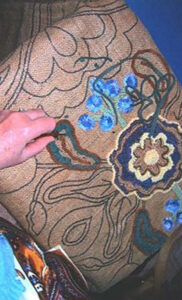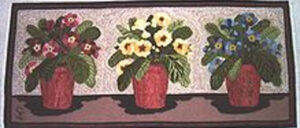HOOKED RUGS
HOOKED RUGS
A craftsperson creates a hooked rug by pulling lengths of cloth, usually wool, through a woven fabric, usually burlap.
Rug hooking is both an art and a craft where rugs are made by pulling loops of yarn or fabric through a stiff woven base such as burlap, linen, or rug warp. The loops are pulled through the backing material by using a crochet-type hook mounted in a handle (usually wood) for leverage. In contrast latch-hooking uses a hinged hook to form a knotted pile from short, pre-cut pieces of yarn.
Wool strips ranging in size from 3/32 to 10/32 of an inch (2 to 8 mm) in width are often used to create hooked rugs or wall hangings. These precision strips are usually cut using a mechanical cloth slitter; however, the strips can also be hand-cut or torn. When using the hand-torn technique the rugs are usually done in a primitive motif.
Designs for the rugs are often commercially produced and can be as complex as flowers or animals to as simple as geometrics. Rug-hooking has been popular in North America for at least the past 200 years.
History of rug hooking
The author William Winthrop Kent believed that the earliest forebears of hooked rugs were the floor mats made in Yorkshire, England, during the early part of the 19th century. Workers in weaving mills were allowed to collect thrums, pieces of yarn that ran 9 inches (23 cm) long. These by-products were useless to the mill, and the weavers took them home and pulled the thrums through a backing. The origins of the word thrum are ancient, as Mr. Kent pointed out a reference in Shakespeare‘s Merry Wives of Windsor. However, in the publication “Rag Rug Making” by Jenni Stuart-Anderson, ISBN 978-1-900371-53-7, Stuart-Anderson states that the most recent research indicates “…the technique of hooking woolen loops through a base fabric was used by the Vikings, whose families probably brought it to Scotland.” To add to this there are sound examples at the Folk Museum in Guernsey, Channel Islands, that early rag rugs made in the same manner were produced off the coast of France as well.
Rug hooking as we know it today may have developed in North America, specifically along the Eastern Seaboard in New England in the United States, the Canadian Maritimes, and Newfoundland and Labrador. In its earliest years, rug hooking was a craft of poverty. The vogue for floor coverings in the United States came about after 1830 when factories produced machine-made carpets for the rich. Poor women began looking through their scrap bags for materials to employ in creating their own home-made floor coverings. Women employed whatever materials they had available. Girls from wealthy families were sent to school to learn embroidery and quilting; fashioning floor rugs and mats was never part of the curriculum. Another sign that hooking was the pastime of the poor is the fact that popular ladies magazines in the 19th century never wrote about rug hooking. It was considered a country craft in the days when the word country, used in this context, was derogatory. Today, rug hooking has been labeled in Canada as a fine art and has gained a much wider respect across the world.
A modern hooked rug from Lebanon, New Hampshire. Rug hooking was originally developed in England as a method of using leftover scraps of cloth.
Since hooking was a craft of poverty, rug makers put to use whatever materials were available. Antique hooked rugs were created on burlap after 1850 because burlap was readily available as grain and feed bags. Fiber and fabric that was no longer suitable for clothing was often incorporated into rugs. In the United States, yarn was not a fiber of choice if one did not have access to thrums. Yarn was too precious, and had to be saved for knitting and weaving. Instead the tradition of using scraps of fabric evolved. However, New England was the site of the development of preprinted designs on burlap, indicating a shift in the status of rug hooking, at least for some. While preprinted embroidery patterns had long existed, it was Philena Moxley of Lowell, Massachusetts who first developed a business stamping embroidery and rug hooking designs about 1868-1871.[1]:?13? At about the same time, Edward Sands Frost of Maine developed a successful rug kit making business catering to women in Northern New England. The industrial revolution was providing people with more free time to read about hooking and other past-times in magazines and catalogs, and to enjoy engaging in them. Hand-hooked rugs were now being seen as providing some elegance in the home.
Yarns, fabrics, and other materials have always been used for hooked rugs in the Canadian Maritimes. The well-known Cheticamp hooked rugs used finely spun yarns and the highly collectible Grenfell mats were meticulously hooked with recycled jerseys. Everything from cotton T-shirts to silk and nylon stockings were cut and used.
The Grenfell Mission had set standards for hooking with silk stockings as early as 1916. Pearl McGown,[2] working at first under the tutelage of Caroline Saunders in the 1930s, has been credited with saving the craft from disappearing in the United States. McGown popularized guidelines for fine shading with wool using various dye methods, and formalized the study of rug hooking. In 1950, after an especially informative week of rug hooking with 15 other rug hooking teachers, McGown was approached to organize teachers’ workshop to further the study of the art, exchange ideas, and pass on techniques. In 1951, hooked rug teachers came together for the first of what became an annual McGown Teacher Workshop. These workshops exclusively used McGown’s own patterns, in recognition of the work and time McGown spent each year on maintaining the program. This tradition lives on through the Pearl K. McGown Teacher Certification and Workshop Program, now sponsored by Honey Bee Hive Rug Hooking Patterns & Supplies.[3] Many well-known hooked rug designers and teachers have passed through the McGown certification program, including Joan Moshimer, Jane Olson, Gene Shephard, Eric Sandberg, Jane Nevins, Gail Dufresne, and Michelle Miccarelli.









